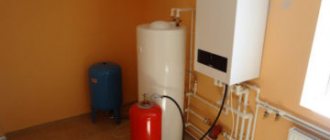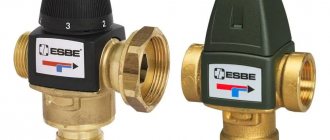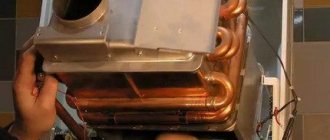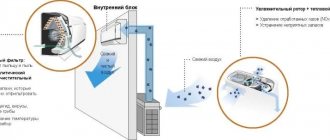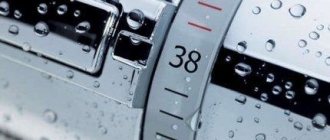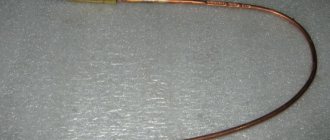The principles of alternative energy are increasingly gaining the attention of consumers. This is largely due to the increase in tariffs on traditional energy resources, as well as periodic disruptions in the services market.
In these circumstances, a hydrogen heating boiler is considered one of the most promising types of devices operating on renewable fuel, which is H2 gas.
Before deciding to purchase such a unit, you need to familiarize yourself with the principle of its operation and evaluate the advantages and disadvantages of using hydrogen as a fuel. These issues have been studied by us and described in detail in the article.
In addition, we identified parameters that should be taken into account when choosing a boiler, provided operating tips and prepared a review of the best factory-made hydrogen generators. Fans of homemade products will find the instructions for assembling the unit with their own hands useful.
Properties of hydrogen as a fuel
As mentioned above, the fuel for such units is hydrogen, the lightest gas in nature, colorless and odorless. Among its advantages is the large amount of heat that is released during the combustion of H2 (121 MJ/kg, while the combustion of propane releases only 40 MJ/kg).
Under normal conditions, hydrogen burns at a temperature of +2000°C, but with the help of a catalyst it can be reduced to +300°C. This allows boilers to be made from inexpensive steel rather than from expensive rare earth metals.
Hydrogen is non-toxic, which makes it safe to use in everyday life. When this substance is burned, water vapor is produced, which improves the indoor microclimate and does not require chimneys.
When using hydrogen, safety rules must be strictly observed: if the gas is used incorrectly or comes into contact with an open flame, a destructive explosion can occur
Disadvantages include the increased explosiveness of hydrogen, especially when it is mixed with air or oxygen, which leads to the formation of detonating gas.
Automation and Security
Solid fuel water-water boilers are equipped with a control and automatic safety unit. Of course, the peculiarities of the solid fuel combustion process do not allow the boiler to provide a level of automation similar to gas or electric boilers; however, installing a thermostat in the heating circuit allows you to control the temperature in the room.
The automation system works on the principle of regulating the air supply through a fan or by opening the damper, which is performed by the actuator, receiving a signal from the temperature sensor and from the electronic unit.
The second level of automation can be implemented by changing the coolant circulation speed set by a centrifugal pump, which is connected to an electronic control unit.
This starts or stops the circulation of water through the pipes, for which the system must have a circulation pump connected to the control electronics:
And the third, higher-quality level of automation of solid fuel boilers is achieved by regulating the fuel supply to the firebox and can only be implemented in pellet boilers.
Advantages and disadvantages of hydrogen boilers
The strengths of such devices are:
- Completely environmentally friendly . Water decomposition products do not harm the atmosphere; they are completely safe for the health of people and pets.
- High level of efficiency , which can reach 96%. This is significantly higher than the efficiency of diesel, natural gas or coal.
- Saving natural resources through the use of alternative energy sources.
- Low price of calories received. For such devices, water and a little electricity are enough.
At the same time, such devices also have weaknesses.
The disadvantages include the following nuances:
- Requiring maintenance . To maximize H2 production, the metal plates must be replaced every year. In addition to replacing the electrodes, a catalyst must be added regularly to produce the planned amount of energy. The frequency of this procedure depends on the power, as well as on the features of a particular model.
- High cost - factory installation will cost no less than 35-40 thousand rubles.
- Danger of explosion when the normalized pressure in the boiler increases.
- There is a shortage of hydrogen cylinders - they are quite rarely found on sale.
- Limited choice . Since such heating devices are not very common on the Russian market, it is not always possible to quickly find a suitable model, as well as find competent specialists for installation and repair of equipment.
- The need for communications . To operate the device, you need a constant connection to the power supply to carry out the electrolysis reaction, as well as to a source of water, the flow of which depends on the power of the device.
It is necessary to mention that manufacturers pay great attention to new technologies and strive to improve hydrogen boilers, eliminating or minimizing disadvantages.
The influence of water quality on boilers
It is important to comply with the quality standards of feedwater and boiler steam. High quality of network, feed, make-up and boiler water ensures the preservation of the life of the boiler installation and reduces the costs of its maintenance and service. For each type of boiler: steam, hot water, water-tube and direct-flow, a coolant with certain indicators is required. Compliance with established regulatory requirements for water quality for the operation of boilers will allow achieving maximum efficiency of thermal power equipment.
Operating principle of the heating unit
Due to its activity, H2 does not occur in nature in its pure form, but it is quite easy to isolate it from ordinary water by electrolysis, which also releases gaseous oxygen.
In the presented image you can see a schematic design of heating equipment operating on hydrogen, indicating all structural elements (+)
For the heating device to function, it is first necessary to obtain H2. This happens in a special compartment reserved for such a reaction. Liquid is poured into the container, into which metal plates are immersed.
They are supplied with an electric current of specially selected purity, under the influence of which H2 and O2 are released, as well as water vapor as a by-product.
The resulting mixture is passed through a special device - a chemical separator, with the help of which it is possible to isolate hydrogen, separating it from other impurities. The purified gas is supplied to the burner, on which a valve is installed.
It prevents H2 from moving to the other side, which prevents an explosion. In this case, oxygen and water vapor are released into a special container through another system.
Next, hydrogen gas passes through the protection unit and enters the combustion chamber. Here it reacts with gas in the presence of a catalyst, resulting in the formation of heat, which enters the home heating system through a heat exchanger.
The water vapor released in the chamber is returned through a specially designated channel to the reservoir with the electrolyte, thus using the recycling process.
Power adjustment is carried out using specially equipped channels, the number of which can reach six. Each of these devices contains a catalyst inside, due to which, when turned on, the process of generating heat starts.
The gas flow, heated to a temperature of 40°C, begins to move towards the heat exchanger located in the combustion chamber.
Thanks to separate designs, the channels can operate independently of each other, which allows you to turn on only part of them.
The process of producing hydrogen in modern electrolysis devices is fully automated. The only manual process is pouring water into the system
Modern models are also equipped with various devices, for example, water level indicators and pressure sensors, which allows them to operate automatically and respond urgently in unforeseen situations.
Types of double-circuit boilers
There are a considerable number of options for boilers with two circuits. We have divided them into segments and will describe each in detail.
By heating method
- Flow-through. Such models are very popular. They are very powerful and allow hot water to flow into the faucet quickly. In such boilers, either two separate heat exchangers are used (one is used to heat the coolant, and the other is used to transfer heat from the heated coolant of the heating system to the hot water supply circuit), or one bithermic (one heat exchanger heats the coolant of the heating system and hot water).
- With built-in tank. Less common. With this design, the water is first heated in a separate tank and only then enters the mixer. Often, such boiler models are purchased quite rarely. Many people prefer to install a separate boiler and indirect heating tank. But such boiler options are quite possible. As an example, you can look at the Baxi Luna 3 Combi boiler.
By installation method
- Wall-mounted. They are extremely convenient, as they can be installed in any room, be it a corridor or a kitchen. At a fairly low price, these models have good performance. On average, they can provide heat to rooms up to 350 square meters in size. Such models are readily installed both in private houses and in apartments.
- Floor-standing. These boilers are more expensive, but they have high power and are capable of heating a huge cottage with several floors. They take up a lot of space, require a separate room and special care. Often, high-power boilers are all single-circuit, which initially means using a separate tank that will be heated by the boiler.
By method of removing liquid
- With open camera. The chamber receives oxygen from the living space. This is not always possible. The disadvantage of this solution is often the lower efficiency of the boiler. Especially if the chimney is mounted “from the bulldozer”.
- With a closed camera. Air from outside is used. They have high power and excellent tightness. They do not require a full chimney. They are usually equipped with a meter-long coaxial pipe, which is sufficient for normal operation of the boiler.
Components of a hydrogen plant
The design of a heating system operating on hydrogen is quite simple.
The boiler , which plays the role of a heat exchanger, is the main element where hydrogen production occurs.
A boiler operating on hydrogen can be assembled from available elements, and for its operation only ordinary or distilled water is required (+)
The electrolyser is the main operating part of the boiler, where the electrolytic reaction occurs, leading to the decomposition of water into H2 and O2. The element is a reservoir filled with water into which metal electrodes are placed that have maximum current conductivity.
The plates are connected to wires through which electricity is supplied.
A burner is a device that helps heat the coolant in the heating system. Located in the combustion chamber, a spark is supplied to ignite it.
The burner valve is a special part located at the top of the device. Thanks to this part, the H2 that rises to the top easily overcomes the barrier inaccessible to other released substances and enters directly into the burner.
Factory hydrogen boilers are equipped with a control unit. The panel displays voltage and current indicators, a power regulator and levers for setting other operating parameters
Pipeline - communications that depart from the unit and are used to supply heat to all rooms of the house. For piping, heating pipes with a diameter of 25-32 mm are used. When laying, the fundamental rule is observed: the diameter of each subsequent branch should be smaller than that of the previous one.
Water for boiler installations: main types
The main sources of water supply for thermal power engineering are open reservoirs, as well as wells: artesian and ground. Water used to ensure the operation of boiler installations and heating systems is classified according to SP 89.13330.2012:
- Raw. An aqueous solution supplied directly from the water source without prior preparation.
- Nutritious. The water has undergone purification and treatment and enters the boiler installation: its chemical composition must comply with current standards.
- Additional. A purified water supply intended to compensate for losses after purging the boiler, in case of water and steam leaks from the system.
- Make-up. Used to compensate for water leaks from water pipes and consuming equipment.
- Boiler room. The coolant directly circulates in the boiler installation.
- Forward and reverse network. Liquid coming from the pressure pipe and located in the section of pipe networks from the consumer to the boiler room.
To meet the requirements for the quality of water in boilers, it is necessary to conduct a study of its composition. Water analysis from open and underground sources is carried out by an accredited laboratory at different periods of the year. In the winter, summer and autumn-spring seasons, the quality and composition of the liquid can vary significantly.
Generator selection criteria
When deciding to purchase such equipment, it is important to pay attention to the following criteria.
Power . With modern devices, the value of this indicator can vary significantly, which allows you to choose the best option for both a small house and a two- or three-story building.
The average water consumption in modern generator models is not too high. Within 24 hours, the device will need approximately 5.5 liters to operate, which generates 1.2-2 liters of fuel
Number of circuits . On devices operating on hydrogen, a heating circuit is usually installed. Some models also provide additional installation of a second (heating) circuit.
Electricity consumption level . Today's technologies make it possible to achieve excellent heat performance while using a minimum of electricity. The energy consumption of different types of generators varies from 1.2 to 3 kW per 1 hour.
Low energy consumption is achieved due to the fact that the hydrogen boiler does not operate continuously, but only to maintain a certain temperature in the room.
Power supply . All types of hydrogen generators can be divided into two large categories: one runs on gas, the other runs on electricity.
Manufacturer . It is better to prefer proven manufacturers (Italy, USA). You should be wary of low-quality products offered by dubious companies at extremely low prices.
Where does pure hydrogen come from?
Note to the owner
“To attract attention to their products, some hydrogen boiler manufacturers make references to some kind of “secret catalyst” or to the use of “Brown gas” in their devices.”
For example, you can extract hydrogen from methane gas, where there are as many as 4 atoms of hydrogen! But why? Methane itself is a flammable gas, so why waste additional energy to produce pure hydrogen? Where is the energy efficiency? Therefore, hydrogen is most often extracted from water, which, as everyone knows, cannot burn, using the electrolysis method. In its most general form, this method can be described as the splitting of water molecules into hydrogen and oxygen under the influence of electricity.
Electrolysis has long been known and widely used to produce pure hydrogen. In practice, not a single industrial hydrogen boiler, at least for now, can do without an electrolysis installation or electrolyzer. Everything would be fine, but this installation requires electricity. So, a hydrogen boiler must necessarily consume energy. The question is, what are these energy costs?
Electrolysis process diagram
All the talk about the “heat of combustion” of hydrogen takes us a little away from this issue, and yet it is the most important. So, a hydrogen boiler can be beneficial in the only case - the thermal energy it produces must be higher than that expended on the operation of the boiler.
Tips for using the boiler
To improve the functionality of the unit, it is important to follow the included instructions. You can improve the operation of the device by adding additional parts (you must strictly follow safety rules).
A flame sensor installed on the burner increases the safety of the system. When the fire goes out, the device automatically shuts off the flow of flammable gas into the burner, thereby preventing it from entering the room
You can install special sensors into the inside of the heat exchanger to monitor the increase in water heating rates, as well as supplement the burner design with shut-off valves.
It is enough to connect it directly to the temperature sensor so that the boiler automatically turns off as soon as the heating reaches the set value.
It is also useful to install a device for normalized boiler cooling.
Hydrogen devices can be used not only as the only heating equipment in the house, but also in combination with other heating systems. In this case, the main heating units can operate in low-temperature mode.
If operating standards are observed, a hydrogen-powered unit will serve for decades. Although the warranty period for such devices is 15 years, in practice they can work efficiently for 20-30 years.
Repairing such devices will not be difficult for an experienced technician, since the basic design of a hydrogen boiler is not too different from analogues operating on other types of fuel.
Quality of feed water for boilers: basic requirements and regulatory documentation
Issues of safety of heat and power networks in our country are regulated at the legislative level. In particular, the quality parameters of purified water for boiler plants are established by Federal norms and rules approved by Order of FSETAN (Rostekhnadzor) No. 116 dated March 25, 2014.
Water quality standards for boilers - the main indicators of liquid coolants - are determined by regulatory documents:
- SanPiN 2.1.4. 2552. Water to compensate for losses from open heat and water supply networks.
- GOST 20995. Feed water, as well as used to reduce the temperature of superheated steam injection methods.
- SNiP II-35-76. Feed water for steam boiler plants with operating pressure up to 0.017 MPa and natural circulation.
Requirements for coolant fluids used in fire tube and hot water installations are established by equipment manufacturers. Such standards are usually indicated in the operating manual or technical data sheet. If necessary, this data should be requested from the manufacturer.
Top 5 Factory Hydrogen Generators
The first company to manufacture and patent the technology for manufacturing a hydrogen fuel boiler was the Italian company Giacomini . It specializes in devices based on environmentally friendly methods of generating energy: geothermal pumps, solar panels and others.
H2ydroGEM is a catalytic combustion chamber, each horn of which contains a substance that accelerates the combustion reaction of hydrogen. Due to this, the process occurs at a relatively low temperature
Currently, similar models are manufactured by American, Chinese, and European companies, but their range is not very wide compared to boilers operating on other types of fuel.
The best factory models of hydrogen systems
Among the most popular models we note:
- MegaTank100 is a generator that runs on electricity from the network. It has a reliable multi-level protection system against overheating and short circuiting, which guarantees safe and productive operation. The cost of the model depends on its configuration.
- STAR-2000 is an expensive unit (>200,000 rubles) with excellent technical characteristics. Despite the fact that this generator consumes minimal energy, it is capable of heating a room of 251-300 square meters.
- Kingkar is a mains-powered device with excellent performance properties. The cost of the model is quite high - about 100 thousand rubles, but it is offset by economical energy consumption.
- H2-2 – Italian “extra” class equipment at a high price (approximately 250,000 rubles). allowing to heat air in large spaces (from 300 m3 and above) with minimal electricity consumption.
- Free Energy - high-quality devices at an affordable price in the range of 15-35 thousand rubles (the price depends on the power and other characteristics). Equipped with a control unit that automates many processes, a multi-level voltage and pressure regulation sensor.
There are also other models in different price categories.
Introduction of a boiler into a heating system
Autonomous heating and water supply from one solid fuel boiler is the simplest and most reasonable solution. All that remains is to figure out how it is tied, and how such systems generally work.
In order for the heating to be not only economical and maximally productive, but also to function trouble-free for many years, it is very important not only to carry out the installation correctly, but also not to neglect the inclusion of additional devices in the system that protect it from all kinds of force majeure.
Next to the boiler is a boiler for hot water supply
And then, the comfort that a person receives with the use of additional equipment is also worth something. For example: a device such as a heat accumulator will solve the problem of moisture condensation on the walls of the boiler due to temperature changes. And in order to not only heat the house, but also provide it with hot water, it is necessary to additionally install a boiler.
We will not claim that all this is easy to do with your own hands, but for successful operation, you still need to become familiar with the nuances of the systems design.
Performing the strapping
The efficiency of solid fuel boilers depends on the combustion temperature of the coolant. This creates certain difficulties in controlling the fuel combustion process. For heating to be effective, it must be stable and not deviate in one direction or another from the range of +60 +65 degrees.
If the boiler is not installed correctly into the heating network, heating can be very uneconomical. Its operation depends not only on the type of system, but also on the number of circuits in it, as well as the presence or absence of additional heat consumption points. The schemes do not have to be standard - after all, houses are all different.
Solid fuel boiler piping
Knowing the features of heating systems and the principle of their operation, you can create any project that takes into account all the individual features of the object. A simple instruction, of course, will not be able to provide all the necessary knowledge; for this you need to seriously study the topic.
But we will be happy to tell you about the standard schemes most often used in low-rise buildings. We will also offer you a video in this article for your viewing pleasure.
Open systems with natural circulation
A system based on the natural flow of air necessary to maintain combustion is the most optimal for solid fuel models. The most valuable thing is that it does not depend on electricity, while additional traction in the form of a fan requires a connection to the network.
Open gravity system with solid fuel boiler
So:
- This system is also called gravitational. It is as simple as possible, quite reliable, and does not require large investments. Therefore, people actively use it, despite its shortcomings. And, of course, we can’t do without them.
- Due to the free access of oxygen, pipes in an open system are more susceptible to corrosion. Also, as a result of evaporation of the circulating coolant (water or antifreeze), there is a need for its constant replenishment. Because of this, the temperature of the reagent at opposite ends of the circuit is uneven.
- However, all this does not create big problems, since oxygen entering the system is quite easy to eliminate. A small amount of mineral-based oil is added to the expansion tank. By the way, it also helps to reduce the rate of coolant evaporation. Naturally, the method is not suitable for hot water supply, but for heating it is quite acceptable.
The basic requirements for installing such a system can be stated as follows:
- In order for the coolant to circulate normally, the entrance to the boiler must be located approximately 50 cm below the entrance to the radiators.
- Since coolant circulation in open systems occurs due to gravity, supply and return pipes must be installed with a slope towards the direction of its movement.
- The expansion tank, without which an autonomous heating system cannot do, should be located as high as possible.
Closed systems
The same expansion tank helps to avoid the negative effects of oxygen in closed systems. Here it can be installed in any convenient place, but it is most optimal to give preference to the return pipe.
Only now the tank will have a slightly different design, and therefore should be designed specifically for closed heating systems.
Arrangement of devices in a closed system
If tanks installed in open systems operate only on water, then closed tanks allow the use of other working fluids - for example, antifreeze. Most often, closed systems are installed when installing a forced draft boiler. They are much easier to adjust and warm up faster when starting.
Expansion tank for closed system
Note! Compared to an open system, there is less temperature difference at the inlet and outlet of the boiler, which is very important for all heating equipment. This allows you to use pipes of a smaller diameter for installation of the system - and this is a direct saving. The closed system is generally universal, and allows you to connect not only radiators of any type, but also heated floors, as well as an additional boiler for hot water supply.
Safety unit for closed heating systems: safety valve, pressure gauge and plunger
When designing a closed system, several very important points need to be taken into account:
- The tank must have a capacity that can accommodate at least 10% of the total coolant volume. Safety fittings must be installed on the supply pipe: a plunger and a valve.
- The plunger is an air vent; air is automatically removed from the system through it. As for the valve, when the pressure in the system increases critically, this device allows you to quickly release part of the coolant from it.
- Typically, the emergency relief valve is set to a pressure of 3 atm, while the normal operating parameter of the network is 2 atm.
Bypass with circulation pump and non-return (anti-drain) valve
And one more significant difference: in closed systems, the coolant moves forcibly - that is, due to a circulation pump integrated into the network. Naturally, it runs on electricity, and in order for the system not to shut down in case of downtime, a bypass branch (bypass) should be provided on it.
This unit allows the coolant to move naturally. The pump can be located either on the bypass or on the return, at the entrance to the boiler. It is not placed on the supply pipe so that if the water boils, steam does not enter the pump.
Boiler connection methods
When it is necessary to connect not one, but several branches (circuits) to a solid fuel boiler, which may include not only radiators, but also hot water supply, a water floor, the system requires precise balancing of the amount of coolant. If it is not provided for, the liquid will move only to where it finds the least resistance, and the remaining branches of the system will not heat up.
Through a manifold or hydraulic arrow
Collectors, called combs because of their unique configuration, which can have either one or several outputs, help to cope with this task.
- Their installation makes it possible not only to evenly distribute the coolant, but also to individually regulate its temperature on the branches of the system.
- Thanks to the manifold, you can install your own circulation pump for each circuit, which also allows you to regulate the heat supply.
- This type of piping has the greatest complexity, and accordingly, the cost of the system as a whole increases. But in terms of convenience and reliability, it has no equal.
Heating manifold
One of the options for manifold piping can be considered to be connecting the boiler to the circuits through a hydraulic separator - a hydraulic arrow. This device is also an intermediary between the distribution pipelines and the boiler.
A hydraulic arrow is a piece of pipe of a larger diameter, with two inlets and several outlets. The inputs are connected to the boiler pipes, and the outputs are connected to the network circuits. This element is most convenient in a system where there will be many circuits with different parameters and temperature conditions.
Hydraulic separator (hydraulic arrow)
Scheme: heating and water supply of the cottage through a hydraulic arrow
Three-way mixing valve
A three-way mixing valve installed after the circulation pump helps regulate the temperature. The supply of hot coolant to the boiler inlet is carried out only by a signal from the temperature sensor, which prevents the boiling process. The valve has two inlets and one outlet, which allows the hot coolant in the supply pipe to be diluted with colder fluid coming from the return pipe.
How to make a boiler yourself
Heating generators have a fairly lightweight design. With a certain level of skill, you can assemble the device yourself. At the same time, due to the explosiveness of the hydrogen mixture, such work requires extreme responsibility, knowledge of safety precautions and experience in installing such devices.
If you manufacture the device yourself, you will not be able to get rid of significant financial costs, since it is better to purchase some of the components ready-made. High risk makes you think about factory installations, for which manufacturers provide long-term warranties
The process of making a hydrogen boiler with your own hands can be divided into several stages.
Step No. 1 - execution of the drawing and preparation of materials . First of all, you should find similar projects on the Internet in order to use them to think about a device that would meet all conditions and possibilities.
It is necessary to accurately calculate all the indicators, and above all, the required power, and also decide on the materials that will be used to make the boiler. Ferromagnetic alloys are considered the best option, but a container made of stainless steel is quite suitable.
Although heating hydrogen generators may have different designs, the following details remain unchanged:
- 12-volt power source;
- the tank where the structure will be located;
- PWM controller with a power of at least 30 A;
- several tubes of different diameters made of stainless steel;
- steel sheet;
- hacksaw for metal;
- gas burner - preferably a ready-made one purchased in a store.
Step 2 - Create Electrolytes . To make the plates with which the electrolyzer will be equipped, you need to take a sheet of steel of medium thickness. Using metal scissors, a hacksaw or another tool, it is cut into equal strips of 18 or more pieces (the number must be even).
On the other hand, in each of them it is necessary to drill holes for the bolts that will be needed to hold these elements completely motionless in the electrolyte.
We divide all plates into anodes and cathodes; depending on this division, wires are connected to them, respectively transmitting positive and negative charges.
Using direct current is more efficient than using alternating current. It is best to use a PWM type generator as its source.
Step No. 3 - assembling the electrolyzer . The best material for the manufacture of this element is stainless steel. A reliable rectangular or square-shaped structure is welded from metal, after which water or a mixture of H2O with a catalyst is poured into it, and prepared plates with connected wires are placed.
Step No. 4 - connecting the burner . A burner is mounted at the top of the device - it is better to use a purchased model, which can be purchased at a specialized store.
Step No. 5 - installation and connection of the separator , which is necessary to separate hydrogen gases from the mixture.
Finally, a tube is laid through which H2 will rise to the burner, and elements are also connected that remove heat and distribute it throughout the house.
How to calculate power
What kind of boiler is needed for warm water floors - an economical one, so we choose it taking into account its performance. To select a suitable model, you need to calculate the power.
The average unit indicator for a suburban building is 1 kW of power required per 10 m2, that is, the specific productivity is 100 W per m2. But this is a fairly rough calculation, which is suitable for a brick building with minimal heat loss.
When installing gas equipment, it is necessary to prepare and coordinate the project with government agencies, and obtain permission from the gas inspectorate. The project has a section that indicates the calculation of the power of the device.
If you plan to place an electric or pyrolysis boiler, then a form is used to calculate the load of the house. The formula is suitable for midland regions; if the apartment is located in the northern regions, a correction factor of 1.2 or 1.3 is used. In case of poor insulation or DHW provision, a coefficient of 1.2 is also applied.
Mk = 0.1*Po*k1*k2*k3, where:
Using an example, we calculate the productivity of a generator for a house of 250 m2 in the northern region, with poor insulation and hot water supply:
Mk =0.1*250*1.2*1.2*1.3= 46.8 kW
If the premises are located in the central area, then the calculation indicator looks like this:
Mk =0.1*250*1.2*1.2= 36.8 kW
If the room is well insulated and hot water supply is not required, then:
Mk =0.1*250= 25 kW
It is not recommended to make a large reserve of power; in addition to increasing the cost of thermal energy, this will lead to overheating of the transformer unit and failure.
Which water is better - regular or distilled?
One of the questions that owners of hydrogen boilers often ask concerns the water used to operate the devices.
Distilled water for the operation of a hydrogen boiler can be purchased in stores or you can set up its production yourself using a simple installation
According to experts, factory or home-made devices demonstrate the best performance when working with distilled water, to which very little sodium hydroxide has been added (one tablespoon per 10 liters of H2O).
However, a hydrogen boiler can also operate successfully on tap water, the main thing is that it does not contain heavy metal salts.
Determination of boiler water quality standards and its impact on boilers
The operating modes of thermal power plants are selected in such a way as to achieve their maximum efficiency. In such conditions, the requirements for the quality of water used in boilers increase significantly, and enterprises organize constant monitoring of its chemical composition according to the following indicators:
- Clarity, alkalinity and hardness.
- Content of chlorides, phosphates, nitrates, iron compounds, other salts and solids.
- Concentration of ammonia, free carbon dioxide and dissolved oxygen.
- Indicators of acid-base balance pH.
Studies of the quality parameters of boiler feed and make-up water are carried out by specialized laboratories using methods approved by the current RTM. Liquid analyzes are performed on the basis of GOST 2761 with the issuance of a written report. Failure to comply with the established water chemistry regime leads to the formation on the internal surfaces of the boiler and pipelines:
- Solid insoluble deposits due to the presence of mechanical impurities in the coolant: silt, sand, scale, manganese and iron compounds.
- Scale. It is formed as a result of a decrease in the solubility of magnesium and calcium salts when water is heated to temperatures above +130 °C.
- Corrosion. The increased electrochemical activity of water causes the destruction of the passivating film, which leads to oxidation of the metal and gradual destruction.
Deposits in heat exchangers and pipelines, which appear due to the fact that water quality requirements for boilers are not met, reduce their effective cross-section and worsen heat transfer processes. Local overheating of the equipment occurs, accumulation of fatigue changes in the metal and its cracking. Destructive processes are aggravated by the formation of scale and pockets of deep corrosion, which leads to failures and accidents of boiler plants. The costs of maintaining and repairing the heating system are increasing.
Conclusions and useful video on the topic
In the video below you will see an overview of a model of a gas boiler running on hydrogen fuel, produced by the famous Korean company DAEWOO.
Hydrogen is not without reason called the fuel of the future: this gas can become an almost limitless resource of cheap, environmentally friendly fuel that can be used in various installations.
A hydrogen fuel boiler, manufactured in a factory or independently, will allow you to create an autonomous heating system. This will help to significantly reduce payments in housing and communal services, and will solve the issue of maintaining a comfortable temperature in living rooms and utility rooms.
Any experience using hydrogen as a fuel? Do you want to ask questions on the topic or talk about your invention? Please comment on the post, participate in discussions and leave photos of your homemade products. The feedback block is located below.
Questions and answers
I called the technician, and he told me that the flame height was set incorrectly and this could lead to a leak in the near future. Is there any point in interfering with the burner?
If the master insists and sees a threat, then it is better to listen to the recommendations and do it before that very hour X comes.
I often notice drops of water on the drain, but I don’t understand whether the problem is condensation or a leaking joint, how to understand and what to do?
Dry the surface of the entire joint, then apply a paper towel to the joining area. Hold for 1-2 minutes. If there is a leak, it will show itself. In such a short period of time, condensation cannot a priori form. The squeegee can be slightly tightened using a gas wrench. If this does not help, then you need to completely replace it.
The boiler leaked. The repairman said there were two small holes in the water heater and advised us to replace it with a new one, since the boiler was almost 13 years old. I would like to try brewing it so as not to waste money. Is it possible to do this and what is the best way to proceed?
If the technician sees the need to completely replace the water heater, then it makes sense to listen, since the problem may not only be due to the presence of through holes. Welding, including cold welding, cannot always guarantee the serviceability of equipment.
To summarize, it should be noted that a leak in a gas boiler does not always occur due to a crack in the water heater. It is necessary to check all joints of the heating system, as well as the serviceability of the radiators. If holes are found, it is better to replace it, since welding will give a temporary effect, and you will still have to spend money on installing a new heating tank.
Rating of the TOP 15 best solid fuel boilers with a water circuit in 2021
| Place | Name | Price |
| TOP 4 best solid fuel boilers with a water circuit in price/quality ratio for 2021 | ||
| 1 | Teplodar Cooper Praktik 8 single-circuit | Find out the price |
| 2 | ZOTA Yenisei 14 14 kW single-circuit | Find out the price |
| 3 | Lemax Forward-16 17 kW single-circuit | Find out the price |
| 4 | Teplodar Uyut-10 10 kW single-circuit | Find out the price |
| TOP 4 best solid fuel boilers with a water circuit and electric heating element | ||
| 1 | Teplodar Kupper Praktik 14 14 kW single-circuit | Find out the price |
| 2 | Teplodar Kupper OK 15 15 kW single-circuit | Find out the price |
| 3 | Teplodar Kupper Expert-15 single-circuit | Find out the price |
| 4 | Teplodar Kupper OVK 18 18 kW single-circuit | Find out the price |
| TOP 4 best cast iron solid fuel boilers with a water circuit | ||
| 1 | Krontif Siberia 60 single-circuit | Find out the price |
| 2 | Kentatsu MAX-04 38 kW single-circuit | Find out the price |
| 3 | Sime SOLIDA EV 6 56 kW single-circuit | Find out the price |
| 4 | Krontif Siberia 30 single-circuit | Find out the price |
| TOP 3 best solid fuel boilers with a water circuit using wood | ||
| 1 | ZOTA Box 8 8 kW single circuit | Find out the price |
| 2 | Teplodar Kupper OK 9 9 kW single-circuit | Find out the price |
| 3 | Lemax Forward-12.5 13 kW single-circuit | Find out the price |
Features of hot water boilers
The liquid circuit version is an upgraded modification of the standard installation.
The design includes:
- the combustion chamber;
- grate of grates;
- ash pan;
- water type cooling jacket.
Single-circuit units are designed for heating homes; double-circuit analogues additionally play the role of a source of hot water supply.
The hot water heating boiler can be loaded with fuel mechanically (manually) or automatically. The second option involves the presence of a special tank that requires filling approximately once every 7 days. Such devices are more expensive than their analogues, which negatively affects their popularity among the population.
Versions with electric heating elements monitor the mass of raw materials in the firebox, adding it if necessary. This allows for continuous operation of the system.
GOST: general requirements
The table shows the basic requirements for the equipment in question in accordance with GOST 21563 93.
| Thermal output (MW) | Outlet water/air temperature (°C) maximum | Coolant pressure (calculated/excessive), kgf/sq.cm | Specific emission of nitrogen oxides (kg/GJ) | Notes |
| From 0.63 to 209.0 | 200/10 | 3,0/2,8 | From 0.09 to 0.21 | The value of these parameters depends on the design of the boiler, the type of fuel and environmental conditions. The tolerance for deviation from nominal values is 5% in both directions. By agreement with the customer, it is possible to manufacture equipment with outlet water temperatures up to 190 °C. |
Before you start operating the unit, you need to study the rules for operating boilers.
